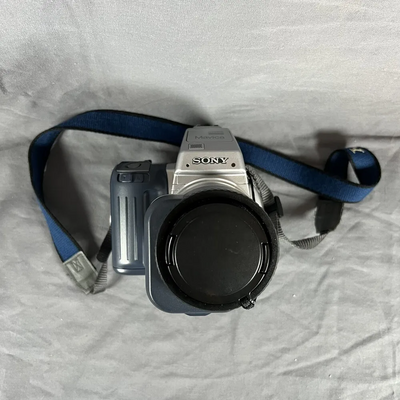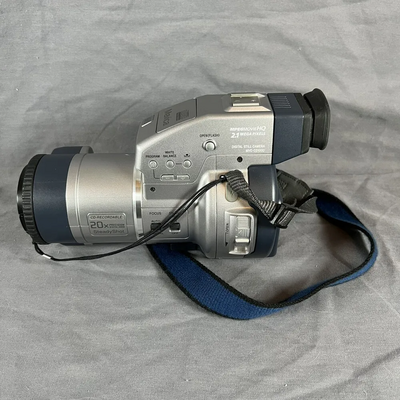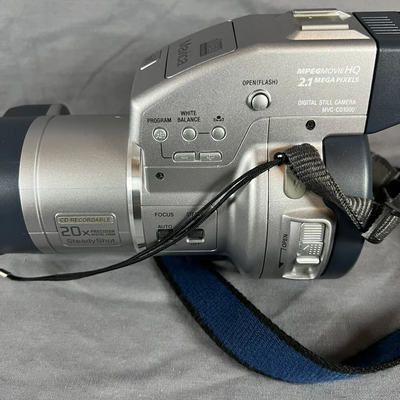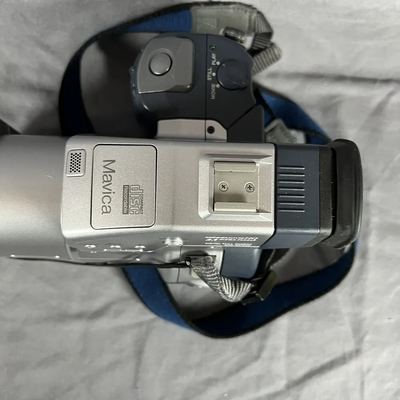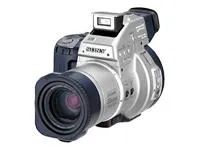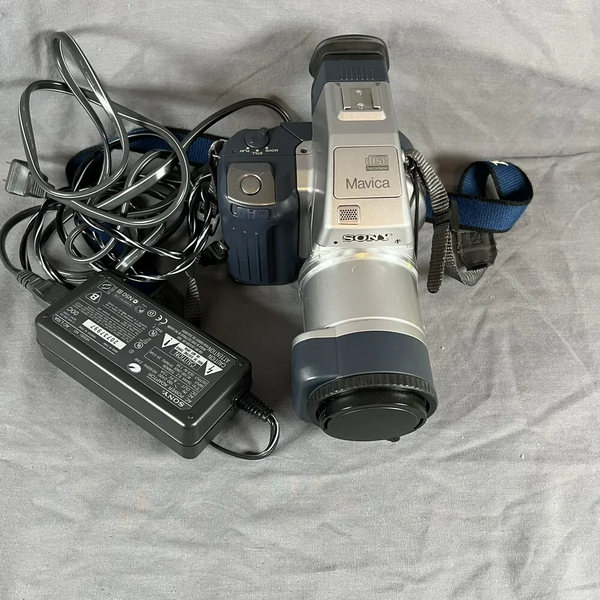
Sony CD1000
| Brand | Sony 1999 |
| Model | MVC-CD1000 |
| Released Year | 1999 |
| Type | DSLR Cameras |
| Series | Mavica |
| Color | Multi-Color |
| Optical Zoom | 3x |
| Status | Discontinued |
Quick view
Overview
The Sony Mavica CD1000 is a pioneering digital camera released in 1999 as part of the Mavica series. It features a 3.3-megapixel CCD sensor providing high-resolution still images for its time. The camera uses a built-in 3-inch LCD screen for image preview and playback, enhancing user interaction. It saves images directly to 8cm Mini CD-R disks, allowing easy storage and transfer. The lens includes 3x optical zoom, offering versatile framing options. It supports standard USB interface for connecting to computers, streamlining image transfer and storage.
Specifications
| MPN | MVC-CD100R |
| UPC | 0027242574380 |
| Model | MVC-CD1000 |
| Digital Zoom | 20x |
| Connectivity | USB |
| Features | Built-in Speaker, USB, Not Interchangeable Lenses, Date/Time Stamp, With Tripod Mount, AE/FE Lock, DPOF Support, Auto Power Save, Rgb Primary Color Filter, USB Compatibility |
| Series | Sony Mavica |
| Optical Zoom | 3x |
| Depth | 8.37in |
| Width | 5.5in |
| Item Weight | 35.2 Oz. |
| Height | 5.25in |
| Screen Details | LCD Display-Tft Active Matrix-2.5"-Color |
| Exposure Compensation | ±2 Ev Range, in 1/3 Ev Steps |
| Light Sensitivity | Iso 100 |
| Sensor Type | CCD |
| Shooting Modes | Frame Movie Mode, Digital Photo Mode |
| Focal Length Equivalent to 35mm Camera | 39-390mm |
| Special Effects | Monotone, Black & White, Negative, Sepia, Negative Art, Solarization |
| Camera Flash Features | Flash OFF!, Fill-In Flash, Flash +/- Compensation, Red-Eye Reduction Flash, Auto Flash |
| White Balance | Auto |
| Focus Adjustment | Autofocus & Manual Focus, Manual, Automatic |
| Operating System Supported | Microsoft Windows 98SE, Microsoft Windows 98, Apple Mac OS 9, Apple Mac OS 8 |
| MAX Shutter SPEED | 1/500 Sec |
| Sensor Size | 1/2.7in |
| Display Size | 2.5in |
| Still Image Format | TIFF, GIF, JPEG |
| Exposure Modes | Program, Aperture-Priority, Shutter-Priority, Automatic |
| Microphone Operation Mode | mono |
| Display Rotation | Built-In |
| Digital Video Format | MPEG, MPEG1 |
| Screen Size | 2.0".5" |
| Light Sensitivity MAX | 100 |
| Type | Point & Shoot |
| Maximum Resolution | 2.1MP |
| Microphone Technology | Electret Condenser |
| Floppy Drive Storage | None |
| Display Type | LCD |
| Color | Multi-Color |
| Sensor Resolution | 2.1MP |
| Exposure Metering | Matrix, SPOT, Center-Weighted |
| Min Shutter SPEED | 8 Sec |
| MAX Video Resolution | 320x240160x112 |
| Additional Features | Built-In Speaker, Ae/Fe Lock, Not Interchangeable Lenses, USB, Date/Time Stamp, With Tripod Mount, Dpof Support, Auto Power Save, Rgb Primary Color Filter, USB Compatibility |
| Flash Type | Pop-Up Flash |
| Min Operating Temperature | 0°C |
| Effective Flash Range | 0.6m-2.5m |
| Run Time Up to | 90 Min |
| Exterior Color | Black & Metallic Silver |
| Microphone Type | Microphone-Built-In-Electret Condenser-mono |
| MAX Operating Temperature | 40°C |
| Connector Types | 1X Composite Video/Audio Output, 1X Flash Terminal, 1X DC Power Input, 1X USB |
| Shooting Programs | Pan-Focus, Landscape, Twilight Mode, Night Mode |
| Flash Modes | Red-Eye Reduction, Forced Mode, Auto Mode, OFF! Mode, Flash ON Mode |
| Camera Type | Point & Shoot |
| Viewfinder Type | Digital, Electronic |
| Supported Flash Memory | 3in CD-R Disc |
| Resolution | 3.3 megapixels |
| Storage Media | 8cm Mini CD-R |
| Display | 3-inch LCD monitor |
| Interface | USB |
| Release Year | 1999 |
| Discontinued | Yes |
Images
Key Advantages
The Mavica CD1000’s unique use of Mini CD media enables direct recording and easy sharing of images. Its 3.3-megapixel sensor was advanced for the era, delivering detailed photos. The incorporated LCD monitor facilitates convenient image review without external equipment. The optical 3x zoom allows flexible composition for various shooting conditions. Its compatibility with widely-available CD technology simplified archiving and distribution. Additionally, the USB connectivity promotes straightforward integration with desktop computers for image management.
Limitations
The reliance on Mini CD-R media imposed longer write times compared to modern memory cards, reducing shooting speed. The 3.3-megapixel resolution, while good at release, limits print sizes by today’s standards. Video recording capabilities were minimal or non-existent, restricting multimedia use. The camera body was relatively bulky due to the CD drive mechanism. Battery life was limited compared to current digital cameras, requiring frequent replacements or recharging. Low light performance was constrained by sensor technology of the time.
FAQ
What type of storage media does the Sony Mavica CD1000 use?
It uses 8cm Mini CD-R disks to store images directly on the camera.
What is the sensor resolution of the Mavica CD1000?
The camera features a 3.3-megapixel CCD sensor.
Does the Sony Mavica CD1000 support video recording?
No, this model is primarily designed for still photography and lacks video recording functionality.
How does the camera connect to a computer?
The Mavica CD1000 includes a USB interface for transferring images to a computer.
Is the Sony Mavica CD1000 still in production?
No, this camera model has been discontinued.
What zoom capabilities does the Mavica CD1000 offer?
It features a 3x optical zoom lens for flexible framing.
What are some limitations of the Sony Mavica CD1000?
Limitations include slow write speeds due to Mini CD media, limited video features, modest resolution by modern standards, and relatively bulky design.
Disclaimer
The content on is provided for general informational purposes only. We do not guarantee the accuracy, completeness, or reliability of any information, specifications, or visuals presented on the site.
is not responsible for any content, images, or data uploaded or shared by users. Users are solely responsible for the content they submit.
We may include links to third-party websites for convenience. We do not endorse or take responsibility for the content or policies of any external sites.
Use of the site is at your own risk. Always verify critical information independently before making decisions based on content from this website.

